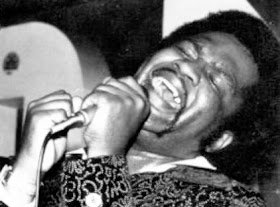James Jay Barnes (November 30, 1943 – December 10, 2022) was an American R&B singer and songwriter who was active for well over 50 years.
Born in Detroit, Michigan, and had seven brothers and one sister (the singer Orthea Barnes). He was educated at the North Western High School in Detroit. His vocal career began with contributions to the groups, The Halo Gospel Singers, The Five Seniors and his own group, J. J. Barnes & The De!l Fi’s. The latter group were signed to the Kable lable, who released the single ‘My Love Came Tumbling Down’ b/w ‘Won't You Let Me Know’ in 1960.
His first professional appearance was in Cincinnatti, Ohio in 1961, where he shared the bill with Aretha Franklin, The Miracles, Luther Barnes and the Emeralds and the Ohio Players. J.J. recorded his earliest sides for the Mickay’s and Scepter imprints, which included ‘Just One More Time’ b/w ‘Hey Child I Love You’, released in 1963, and issued on both labels. Further releases included ‘These Chains Of Love’ b/w ‘Color Green’ (in 1963) and ‘Please Let Me In’ b/w ‘I Think I Found A Love’ (in 1965), following a label move to Ric-Tic. These early sides became highly sought after on the U.K.’s Northern Soul scene.
At Ric Tic, J.J. covered The Beatles' ‘Day Tripper’ b/w ‘Don't Bring Me Bad News’,after which he switched labels to Motown. Barnes was a member of the Holidays, a trio which also included Edwin Starr and Steve Mancha. They had a #7 R&B hit in June 1966 with "I'll Love You Forever" (#43 in Canada). Barnes' biggest hit single came in 1967 with "Baby Please Come Back Home" on the Groovesville label, which, like many of his records, he co-wrote. The song reached No. 9 on the US Billboard R&B chart, and No. 25 in Canada. However, subsequent singles on a variety of labels, including covers of "Black Ivory" on Today/Perception Records, failed to repeat the success.
He left the label the same year, and recorded sides for the Revilot and Groove City labels between 1967 and 1969. On the recommendation of his friend Edwin Starr, Barnes moved to England in the 1970s. Starr had arranged for Barnes to appear on a series of shows, which led to him signing a deal with Contempo Records who released several singles (including ‘Sara Smile’ b/w ‘Let Me Feel The Funk’ and ‘The Erroll Flynn’ b/w ‘She's Mine’) and an album, entitled ‘Sara Smile’ in 1977, all without chart success.
In the 1980’s J.J. released material for Ian Levine’s Motorcity imprint, and released a version of the Northern soul evergreen by Frank Wilson, ‘Do I Love You (Indeed I Do)’. His song "Chains of Love", originally the B-side of his 1967 hit "Baby Please Come Back Home", achieved further renown when it was covered by the Dirtbombs on their Ultraglide in Black album in 2001.
J.J. Barnes only had a brief period in the mass public spotlight, but he maintained a fiercely loyal fan base for over a half century, and he continued to please them with his performances right until the end. In October 2022, Barnes headlined the Detroit A-Go-Go Festival, a destination event for fans of classic Detroit soul music. Barnes said it would likely be his last public performance, and he was right -- J.J. Barnes died on December 10, 2022 at the age of 79.
(Edited from Soulwalking, Wikipedia & AllMusic)






















































